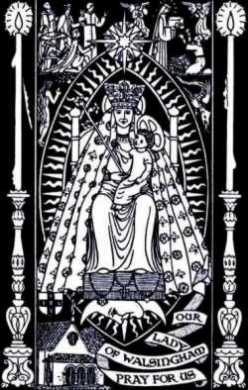From the approach.


 The Twelth Station.
The Twelth Station.If you travel five minutes in the car from my house, you will reach Clifton on the one side, and The Cliff on the other. The Cliff was the home of the wealthy Russian Orthodox cotton barons who made Manchester the centre of the Industrial Revolution and Clifton was the centre of mining operations for many years. The Cliff boasts many fine Georgian houses (and, on a litle cobbled back lane, the Star Inn, which looks as though it has been transplanted from the deepest countryside and where one can still play Manchester Darts, but more of that another time) but they are generally converted into flats now. It stands, as the name suggests, on the edge of a great cliff, the Judges Lodgings towering over the rest of Manchester. The cliff is almost invisible, however, from any other angle, as at the bottom runs the only part of the Irwell which is set in a valley. At the bottom of the cliff, Clifton begins, now home to a Young Offenders Institution, very expensive housing and a tile works called Pilkingtons. This valley deepens and widens to Kearsley, until it forms a gentle undulation on one side, but another steep cliff on the other. If you stand ourside the Three Horseshoes at Ringley and look in the right direction, you can see this cliff rising up, crowned by a tiny, white chapel. You approach this from a busy road, with no idea that just on the other side of the houses is this great valley. Taking a tiny side road, passing a field which, when I passed, boasted two rastafarians gently herding a single goat, one reaches this remarkable place.
It was built by the Renewal order of the Schoenstatt Fathers, founded in Germany in relatively modern times. There are a hundred and eighty six such shrines around the world, echoing the chapel in which their founder began the order with a bunch of teenagers, asking the Mother of God to make that and subsequent shrines places of grace and healing for the countries in which they were built. The building is rich with symbolism, with stones, slates and wood taken from many other shrines as well as holy places from around the world, including a piece of stone from Walsingham Abbey. The Altar is a replica, albeit a smaller one, of the altar in that first chapel where the order was founded and the cross is the one typical to this order. It is also possible to follow the stations of the cross around the gardens, all the better to see this extraordinary Chapel in it's incongrous setting.
It is a rather special place, one can light a votive candle and spend some time in quiet prayer just seconds from a busy road. That in itself is worth the price of admission which, as it says over the door, is the death and resurrection of the Son of God.
You are encouraged to offer up the shrine prayer, which ends in this way....
Mother Mary, I come to you with my cares and worries. I ask for you to implore for me the inner peace and confidence of the holy Spirit.
I commend to you all those who are dear to me : I trust your might, your kindness, Mother dear, I do believe that you are always near. Whatever happens, Mother mild, I blindly trust in you and in your Child. Amen.




_Black_s_s_s_s_s.jpg)
